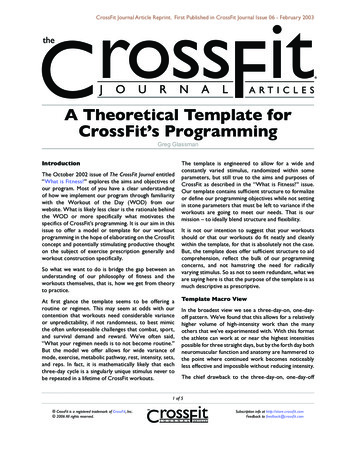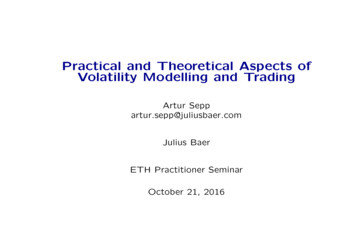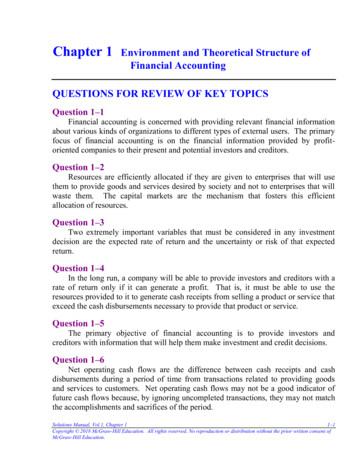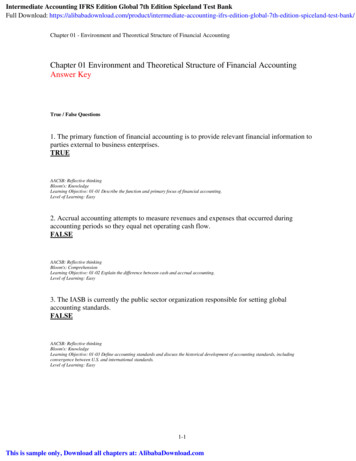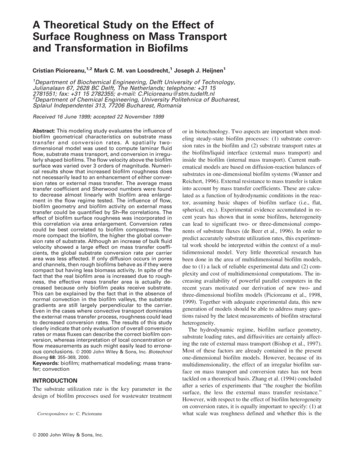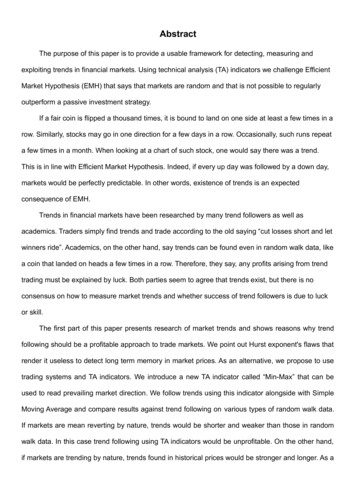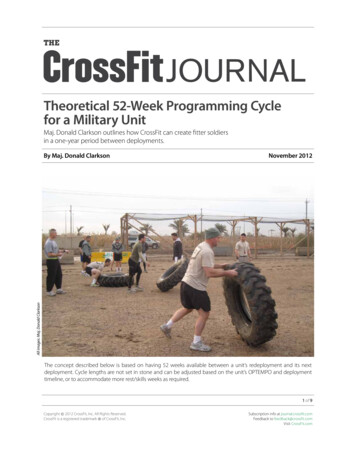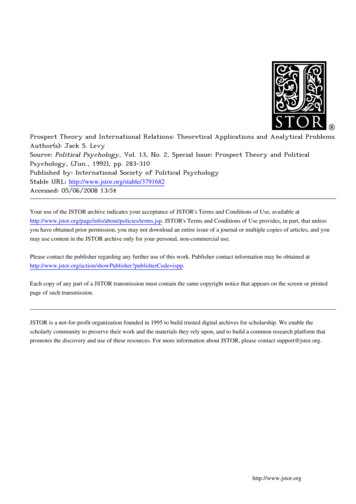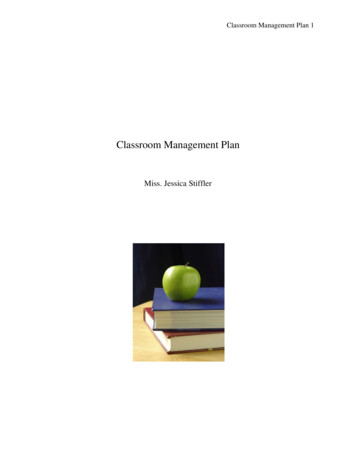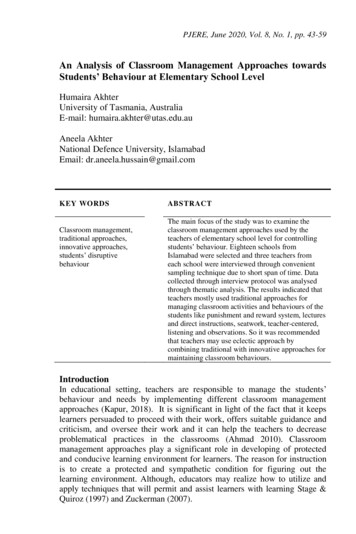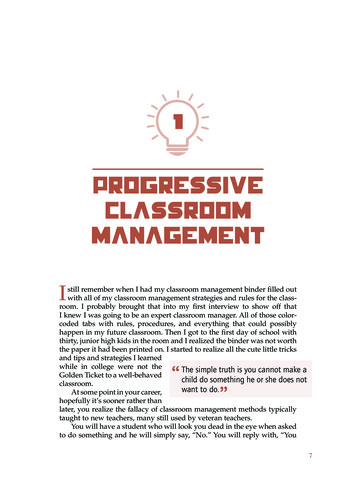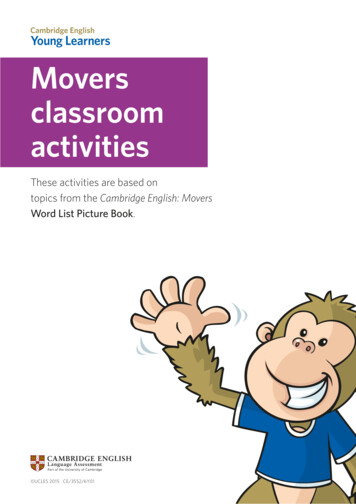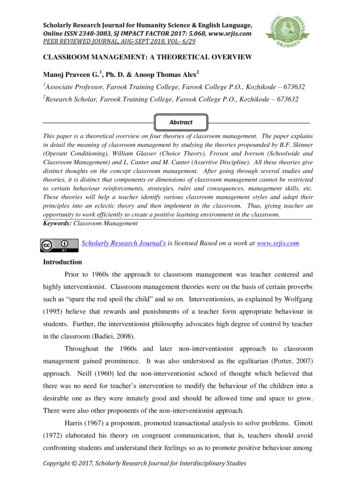
Transcription
Scholarly Research Journal for Humanity Science & English Language,Online ISSN 2348-3083, SJ IMPACT FACTOR 2017: 5.068, www.srjis.comPEER REVIEWED JOURNAL, AUG-SEPT 2018, VOL- 6/29CLASSROOM MANAGEMENT: A THEORETICAL OVERVIEWManoj Praveen G.1, Ph. D. & Anoop Thomas Alex21Associate Professor, Farook Training College, Farook College P.O., Kozhikode – 6736322Research Scholar, Farook Training College, Farook College P.O., Kozhikode – 673632AbstractThis paper is a theoretical overview on four theories of classroom management. The paper explainsin detail the meaning of classroom management by studying the theories propounded by B.F. Skinner(Operant Conditioning), William Glasser (Choice Theory), Froyen and Iverson (Schoolwide andClassroom Management) and L. Canter and M. Canter (Assertive Discipline). All these theories givedistinct thoughts on the concept classroom management. After going through several studies andtheories, it is distinct that components or dimensions of classroom management cannot be restrictedto certain behaviour reinforcements, strategies, rules and consequences, management skills, etc.These theories will help a teacher identify various classroom management styles and adapt theirprinciples into an eclectic theory and then implement in the classroom. Thus, giving teacher anopportunity to work efficiently to create a positive learning environment in the classroom.Keywords: Classroom ManagementScholarly Research Journal's is licensed Based on a work at www.srjis.comIntroductionPrior to 1960s the approach to classroom management was teacher centered andhighly interventionist. Classroom management theories were on the basis of certain proverbssuch as “spare the rod spoil the child” and so on. Interventionists, as explained by Wolfgang(1995) believe that rewards and punishments of a teacher form appropriate behaviour instudents. Further, the interventionist philosophy advocates high degree of control by teacherin the classroom (Badiei, 2008).Throughout the 1960s and later non-interventionist approach to classroommanagement gained prominence. It was also understood as the egalitarian (Porter, 2007)approach. Neill (1960) led the non-interventionist school of thought which believed thatthere was no need for teacher’s intervention to modify the behaviour of the children into adesirable one as they were innately good and should be allowed time and space to grow.There were also other proponents of the non-interventionist approach.Harris (1967) a proponent, promoted transactional analysis to solve problems. Ginott(1972) elaborated his theory on congruent communication, that is, teachers should avoidconfronting students and understand their feelings so as to promote positive behaviour amongCopyright 2017, Scholarly Research Journal for Interdisciplinary Studies
Dr. Manoj Praveen G. & Anoop Thomas Alex(Pg. 8089-8102)8090students. Teacher Effectiveness Training by Gordon (1974) elucidated the way teachersshould actively listen to the issues of the students and communicate to students. Kohn (1996)explained the concepts of discipline and student directed learning. These were some of themajor non-interventionist approaches to classroom management.Interactionalists stress that students learn necessary behaviour as a result ofencountering the outside world of people and objects (Badiei, 2008).Thus, theinteractionalists believe that the students and teachers share the responsibility of classroommanagement. Approaches to responding to misbehavior (Wachtel,1999), Albert (as cited inGriffith, Cooper &Ringlaben, 2002) on Cooperative Disciline, Judicious Discipline(Gathercoal, 1990) and Discipline with Dignity (Curwin&Mendler, 1988) are some of themajor studies based on the interactionalist ideology and approach to classroom management.Dreikurs, Gruwald& Pepper (1982), Kounin(1970) and Glasser (1992) provided theframework forinteractionalist approach to classroom management (Wolfgang, 1995).The earliest known systematic empirical study on classroom management wasconducted by Jacob Kounin (1970). Kounin (1970) focused on classroom management asmastery of techniques that enables teachers to programme for individual differences andindividual students. Baumrind (1970) explained the concepts of socializing a child whichoffered different styles of parenting namely authoritative, authoritarian and permissive. Thisapproach was used in the classroom back then.After 1970 many studies emerged worldwide on the classroom management.Canter &Canter (as cited in Charles and Senter, 2005) advocated Assertive Discipline whichestablished teachers to help form a structure in the classroom without hindering into thestudent rights. This Assertive Discipline training programme has since been given to teachersworldwide.According toEgeberg, McConney and Price (2016) in 1960s and 70s thetheoretical foundation for teachers on classroom management was applied behaviouranalysis.Glickman and Tamashiro (1980) introduced an instrument called Beliefs onDisciplinary Inventory which is used in clarifying teachers’ beliefs on discipline so they canselect strategies with which they are comfortable.In 1980s studies on classroom managementpointed out that instruction and management are layered upon each other (Doyle, 1986).Classroom management is inclusive of both behavioural and instructional management(Glickman &Tamashiro, 1980; Wolfgang & Glickman, 1986).Copyright 2017, Scholarly Research Journal for Interdisciplinary Studies
Dr. Manoj Praveen G. & Anoop Thomas Alex(Pg. 8089-8102)8091The Theory of Reinforcement (Skinner, 1953) gained prominence as an approach toclassroom management in the later 1980s and the 1990s. In the Skinner model the teachersdirect student behaviour to get desired outcomes and effective management (Omomia &Omomia, 2014). Brophy (1996) stated the importance of teachers as effective classroommanagers who should focus on creating positive learning environments by preparingandteaching interesting lessons and supervise students.From the late 1990s to the present focus of research on classroom management ismore on the area of creating positive environment through teacher-student collaboration inthe classroom in solving the problems. Oliver & Reschly (2010) supported the positivelearning environment methods which produce and increase constructive interactions resultingin successful classroom environment.Martin, Yin, and Baldwin (1998) developed theClassroom management Style Inventory which measured teachers' styles to the classroommanagement in three broad dimensions such as instructional management, peoplemanagement, and behavior management. The Choice Theory (Glasser, 1998) has influencedclassroom management by teachers creating environments and curricula that cultivateappropriate behavior through meeting learners' needs for belonging and the feeling ofempowerment.Froyen and Iverson (1999) found that classroom management focuses on three majorcomponents such as Content Management, Conduct Management and CovenantManagement. Hardman & Smith (1999) argued that teachers should create by workingtowards positive learning environments by identifying conditions in the classroom andimplement activities that promote desirable behaviour in the classroom. The actions taken byteachers to create a supportive and positive learning environment will facilitate the academiclearning of the students and also, they may adhere to the rules prevalent leading to socialemotional learning (Evertson & Weinstein, 2006). McDonald (2010) worked on the PositiveLearning Framework and explained that a teacher by developing a systematic learningenvironment, students can engage in meaningful activities that support their learning in anorderly manner. Banks (2014) found that teachers who create positive classrooms pay closeattention to even little details in the environment which stimulate the behaviour of students inthe classroom. Egeberg, Mc Conney and Price (2016) appropriately found that teachers’approach towards students vary according to their theoretical orientation.Copyright 2017, Scholarly Research Journal for Interdisciplinary StudiesTherefore,
Dr. Manoj Praveen G. & Anoop Thomas Alex(Pg. 8089-8102)8092classroom management includes actions by teacher to create, implement and maintain apositive learning environment.What is Classroom Management?Effective classroom management is the process of organizing and conducting aclassroom so that it maximizes student learning (Kellough & Kellough, 2011). Henley(2010) identifies classroom management as the essential teaching skill and suggests effectiveteachers minimize misbehaviours to reduce interruptions and create learning environmentsthat allow for students’ intellectual and emotional growth. Wong & Wong (2014) believedthat classroom management is all of the things that a teacher does to organize students, space,time and materials so that student learning can take place. Effective teaching and learningcannot take place in a poorly managed classroom. McDonald (2010) suggests classroommanagement involves teacher actions and instructional techniques to create a learningenvironment that facilitates and supports active engagement in both academic and social andemotional learning.Gay (2006) argues that classroom management is more comprehensive thancontrolling student misbehaviour and administrating discipline. It involves planning,facilitating, and monitoring experiences that are conductive to high levels of learning for awide variety of students. It also involves creating and sustaining classroom environments thatare personally comfortable and intellectually stimulating. Kunter, Baumert and Köller (2007)assert that classroom management generally is conceived to includes all actions taken by theteacher to ensure order and effective time use during lessons. Wubbles (2011) identifies thatclassroom management has two distinct purposes: it seeks to establish an orderlyenvironment so students can engage in meaningful academic learning and it aims to enhancestudent social and moral growth. Brophy (1988) explained that classroom management refersto creating a learning environment which support successful instruction that is “arranging thephysical environment, establishing rules and procedure, maintaining students’ attention tolessons and engagement in activities” (p.9).What s Classroom Management Problem?After extensive reading on classroom management one can come to the conclusionthat classroom management problem is whatever that hinders or obstructs the academiclearning of the students in the classroom, such asstudent misbehaviour leading to low studentlearning; ineffective teaching methods employed by teacher; lack of infrastructure leading toCopyright 2017, Scholarly Research Journal for Interdisciplinary Studies
Dr. Manoj Praveen G. & Anoop Thomas Alex(Pg. 8089-8102)8093low student learning; lack of learning aids leading to low student learning; lack of previousknowledge of students leading to low student learning; cultural differences among studentsleading to low student learning,etc.Theories of Classroom ManagementIt is important how teachers manage their classrooms to make it into an effectivelearning environment.In a classroom all students learn differently (Pashler, McDaniel,Rohrer & Bjork, 2009) and choosing an effective instructional method could alleviatebehavioural problems of the students.A teacher’s orientation towards classroommanagement is significant as it forms the classroom management theory of the educator(Egeberg, McConney and Price, 2016).Classroom management theories are constantlyevolving according to the day and age. However, there are major theories which will alwayshelp the educators to acquire necessary knowledge on how to solve a classroom managementproblem.B.F. Skinner’s Operant ConditioningB.F. Skinner involved the principles and ideas of behaviourism in his work andcontributed immensely towards understanding human behaviour. Through his research withanimals he found out that it is possible to produce desirable behaviour outcomes throughrewards and undesirable behaviour through punishment so as to modify the behaviour into afavourable one (Skinner, 1953). Originally, Skinner’s work on operant conditioning was notdesigned to address classroom management, however, the ideas that he developed could beused successfully to solve classroom management problems.Omomia&Omomia (2014) view that Skinner’s operant conditioning principles haveinfluenced education and the greater influence is on classroom management.Theinstructional objectives, programmed instruction, mastery learning and behaviour analysis aresome of the areas which it has influenced. Skinner’s operant conditioning is based on theconcepts of reinforcement and punishment. Skinner (1986) aptly believed that an individualcannot learn by doing something alone but learns on the basis of the consequences that followafter the performance. That’s why he used the term reinforcement.If a student adheres to the rules of the classroom that means the child is producing afavourable behaviour which should be reinforced with a reward. On the other hand, if thatchild disobeys the rule, that means the behaviour is unfavourable which should be reinforcedwith a punishment. Therefore, reinforcement could be positive or negative. Reinforcement isCopyright 2017, Scholarly Research Journal for Interdisciplinary Studies
Dr. Manoj Praveen G. & Anoop Thomas Alex(Pg. 8089-8102)8094meant for behaviour to be increased and one should keep in mind that rewards andpunishment should follow right guidelines (Tauber, 2007).Positive reinforcement is given when a desirable behaviour occurs and is rewarded sothat it continues to occur. For example, congratulating students on the completion of theirtasks, rewarding the students with extra marks, rewarding those who scored well in the tests,etc. this proper use of reward could solve certain problems lingering in the classroo
conducted by Jacob Kounin (1970). Kounin (1970) focused on classroom management as mastery of techniques that enables teachers to programme for individual differences and individual students. Baumrind (1970) explained the concepts of socializing a child which offered different styles of parenting namely authoritative, authoritarian and permissive. This approach was used in the classroom back .
